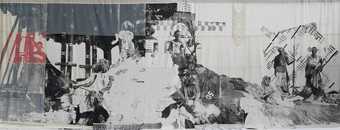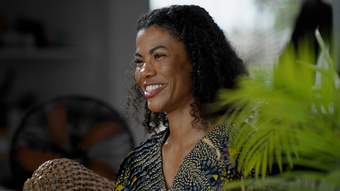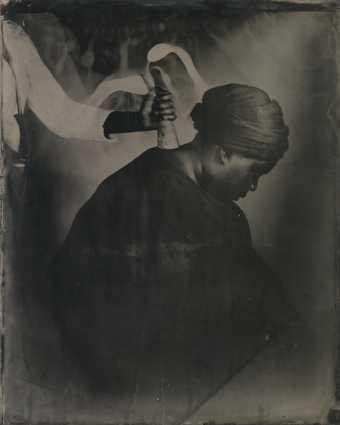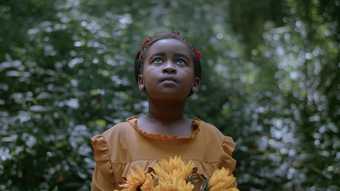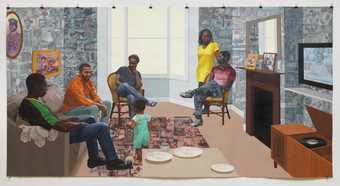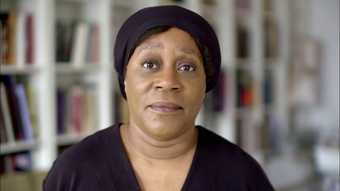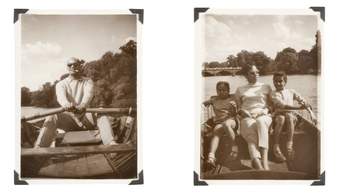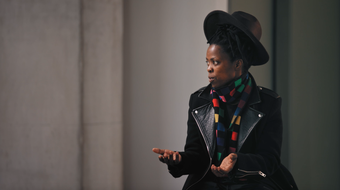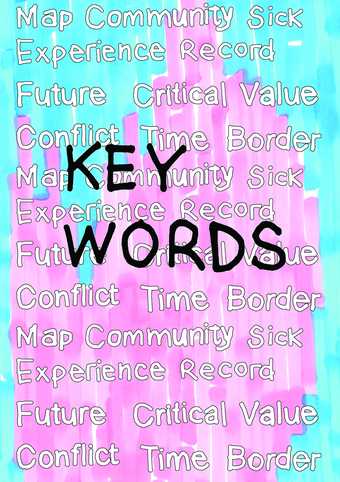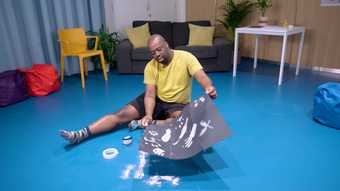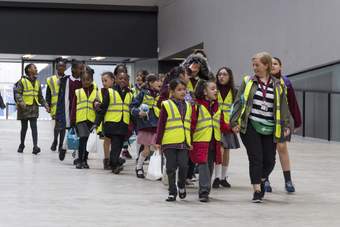This resource was developed with Dianne Minnicucci, Head of Photography at Thomas Tallis School and founder of Visible Diversity.

A World In Common Teachers Private View, Tate Modern 2023. Photo (c) Tate (Eugenio Falcioni)
How can you explore ideas of identity, history, and family through art?
Black Histories in the Classroom offers new and exciting ways for your students to engage with Tate’s collection. Devised to increase teacher confidence in discussing race and cultural differences in the classroom, each resource is co-created with teacher experts, and rooted in anti-racist practice.
This resource will support you to use the following creative strategies to have conversations about heritage and belonging with your students:
- Starting from yourself: bringing lived experience to the art, starting with yourself
- Collaboration: working with others, listening, dialogue, making connections
- Layering: playing with what is hidden and what is shown, blueprints, relationships
- Repetition: doing things again, noticing difference/sameness in repetition
Explore the Artwork
Zohra Opoku is a Ghanaian-German artist working with textiles, photography, and printmaking. She makes large-scale tapestries that explore ideas of history and culture, fashion-related waste, textile production, connections to land, and globalisation. This piece, Queens and Kings, is semi-autobiographical, with photos of Opoku and her siblings printed onto the fabric. They wear second-hand T-shirts and traditional Ghanaian fabrics, showing us the complicated story of how fashion across the world impacts people in Ghana today.
Starting from yourself
"I took a year 7 class to see Queens and Kings. Standing in front of it I encouraged the students to take a longer look and they were able to see visual connections such as colours and shapes. They were able to ‘read’ the images."
Dianne Minnicucci
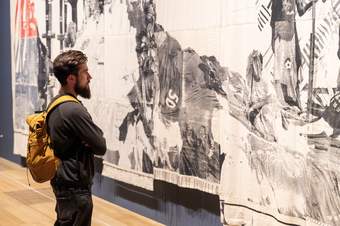
A World In Common Teachers Private View, Tate Modern 2023. Photo (c) Tate (Eugenio Falcioni)
Let’s look at this artwork in more detail. Using the prompts below, encourage your students to explore Queens and Kings closely and discuss their ideas together.
- What do you think that the work is about?
- Why do you think that the artist presented the work in this way?
- How would you describe it?
- Have you seen art like this before?
- If you could create your own image in this style, who or what would be in the image? Why?
Collaboration
“The collaborative part of [Opoku’s artwork] is very important to me. Collaboration is something that I’ve always been interested in.”
Dianne Minnicucci
Collaboration is a big part of Opoku’s work. By sewing together separate pieces of fabric to create Queens and Kings, she references a traditional Ghanaian fabric called Kente cloth, which is woven together from strips of cotton or silk by skilled craftspeople. This idea of combining things together can be seen in all of Opoku’s work. In the video below, you can hear about her collaborations with sewists and makers to create her large-scale tapestries.
For Dianne, collaboration is a very important classroom practice too. Opoku’s references to her mixed cultural heritage felt like a form of collaboration between the two countries; this could inspire students to celebrate their own heritages through art.
Support your students to have conversations around heritage and belonging. Invite them to discuss their own memories with each other; a visit to their family, a day out with friends, even a favourite meal! Where do these conversations lead them? What points of connection can they discover by exchanging their ideas and experiences?
Make it yourself!
Layering
“I love work that is multi-layered... layers of meaning but also physically and in the materiality... With photography, I love double exposure as another way of exposing multiple layers at the same time, some of them are hidden, some of them are there for you to see. It’s quite complex, as is life sometimes, it can be quite complex, and just to have it there on the screen, it’s like a visual reminder of a continuous journey that we’re on.”
Dianne Minnicucci
Layering is a useful technique that your students can use to tell stories about their lives, families, and heritages. Use this activity to explore layering and collage with your students!
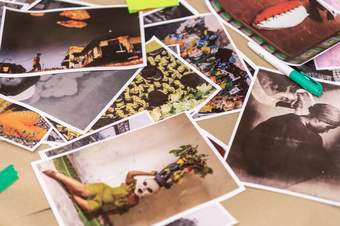
A World In Common Teachers Private View, Tate Modern 2023. Photo (c) Tate (Eugenio Falcioni)
Create a collaborative tapestry with your class to share stories, ideas, and heritage!
Before you begin
To prepare for this activity, ask your students to bring in things that represent them. This could include photographs of themselves, their family or friends, their hobbies and interests, objects or patterns that remind them of home. Once at school, photocopy their items to create images for your students to work with.
You can also photograph and photocopy artworks, objects, and more that you are exploring in your classroom for this activity.
Invite your students to draw a spider diagram exploring the things that they think are important about their home, family, or friends. What do they choose to focus on? Why?
You will need
Drawing paper, A large sheet or roll of lining paper, Pre-printed images, Safety scissors, Glue sticks, Stencils, Colourful drawing materials (pens, pencils, crayons, paint, or anything else of your choosing)
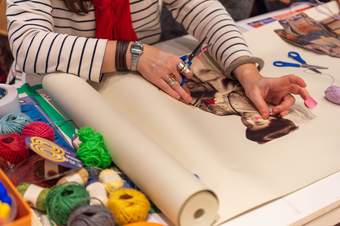
A World In Common Teachers Private View, Tate Modern 2023. Photo (c) Tate (Eugenio Falcioni)
Instructions
- Roll out the lining paper for everyone to work on together in groups
- Cut out a few of the people, objects, or patterns from your photocopied images using safety scissors
- Stick your images to the lining paper to create a collaborative collage
- Use the stencils to add words about your family and friends, your home, and your culture(s).
- Use the rest of the material to draw, paint, and add to the collage together!
Repeat, Adapt, Extend
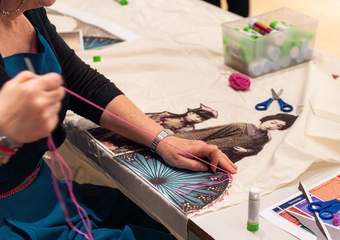
A World In Common Teachers Private View, Tate Modern 2023. Photo (c) Tate (Eugenio Falcioni)
For further support with building your anti-racist, inclusive classroom practice, explore these resources by our partners NSEAD: Anti-Racist Art Education (ARAE) Resources | NSEAD
Discover More Artists
“If you’re sitting in front of a classroom where you’ve got four or five, or even six different nationalities, the work you show them must really reflect who they are so that they are more engaged in the work and more likely to research something on their own.”
Dianne Minnicucci
Once you’ve finished this activity, bring more artists who explore Black histories into your classroom! Here are some examples for you to discover.

